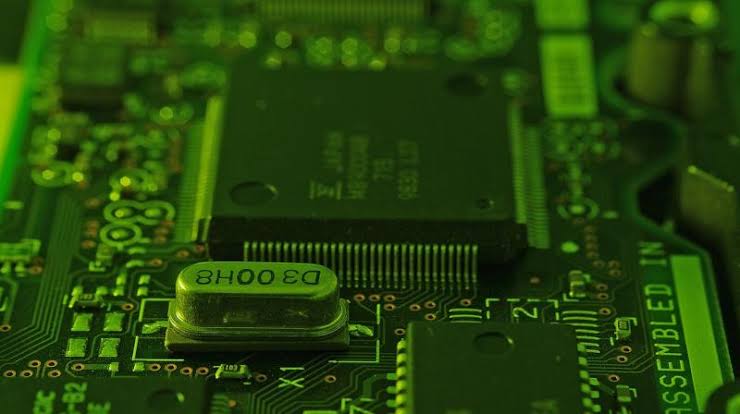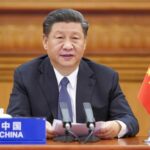
China is moving up the ladder so fast that we have no doubts who will be the number one in the world after a few years. Another reason for this prediction which may not be liked by many but unfortunately holds good is the manner in which China is planning and implementing things from one belt one road to lending money and gaining critical ports, hijacking the cyber and semiconductor works, leading in AI, solar and space technologies, mastering quantum computing , mobile etc etc. However the issue in most of these tech fields and projects is the intentions of the dragon behind them which makes the whole affair look suspicious and not something from which the world too can benefit or mutually beneficial. Its a slippery road as was seen when the Sri Lankan govt lost control of their port and hsad to handover to China after being unable to pay the dues it borrowed from China. It may be the final and last wake up call for the hardware and software industry and also Meity and DoT to do something substantial.
AS a case study and what we can do , we will focus in this post on a new technical development that if goes well may threaten the world and also us with the chinese hegemony plans. The objective of this post is to review the implications for the launch of Huawei Harmony OS in the medium term for India
First, it is important to understand what it promises to be , so here are the basics of the project:-
- It is an Open Source software similar to Android and controlled and developed by Huawei.
- It is currently restricted for use in China and post validation will be open to the larger global market
- Ubiquitous software linking multiple hardware platforms from Mobile Phones to Smart Wearables to TVs and Home Appliances. Ie application developers need to build one application across multiple smart devices – TV, Mobile Phone, Watch, etc.
- Can work on RAM footprint as small as 128Kb
- It offers seamless connectivity to Windows PC thru an App
- Takes the Cloud to the Edge- ie customer is able to take his data/content from one device and use it seamlessly on another device without intermediation
- All of this is managed by applications on the platform which can be hosted on the smartphone – as in the use case demonstrated at launch. But it can also be you on TV
- Gaming is also shown as a use case along with faster rendering – not clear if this is something that moves across devices, If eventually, one is able to use the processing power of the latest smartphone to play a game on a large TV screen without latency
- The global Application developers – who form a critical part of the ecosystem, are largely driven by the deployed base and if adapting the new OS means access to Chinese Market, they will quickly develop their products on this platform.
- These interpretations are based on internet based reading and discussions with stakeholders involved in this OS.
In a nutshell, it is clearly an ambitious software platform that addresses the need for integrating multiple devices seamlessly for the consumer; if there is ever a need for it. A first Operating System addressing the exponentially growing hardware linked digital footprint of the consumer. It is expected that very soon, this OS will be deployed in China – first on the Huawei legacy devices.
(At the expense of AOSP – the open source version of Android) being used in China) .
This leads to key question now –ie. who will adapt this platform and how soon. ? What are the key enablers for driving wider adaption: -?
- Integration of the software by leading semiconductor companies – Already started with Qualcomm – Huawei Tablet announced recently is based on Qualcomm Snapdragon processor and support this OS. For mobile phones can UNISOC and MTK be far behind? These three form 100% of the non-Apple Smart Phone ecosystem.
- It can be expected that most of the Chinese Semiconductor companies ( Realtek, Unisoc, JL, and a lot of the smaller players, ) all will start supporting this OS soon enough.
- HiSilicon is the leader in Chinese Smart TV deployments. Skyworth, one of the leading Smart TV manufacturer has already announced products based on this new OS. HiSilicon is also owned by Huawei. Can other players like Realtek, Medai Tek afford not supporting this OS?
- This OS makes product development and testing cycles for the design house much more simple. The multitude of Real Time OS ( RTOS) supporting myriad smart devices ranging from watches to refrigerators would become redundant and a single OS will potentially emerge. Availability of software expertise becomes easier and easily transferable across companies.
- This solution potentially gives rise to some real life use cases which the customer can use –breathing new life into the dead Smart Home Appliances business. Current generation of Smart Appliances are stand alone and don’t work across multiple brands – each brand has its own Application. This limits the end consumer adoption
- While the monetization aspects have not yet been clarified, one can imagine that it would follow models similar to Google’s Android platform. Smaller manufacturers who have not yet been able to tap into this pool of revenue may now get access to it. Eg. A small smart watch company like Huami ( Amaze fit) will get access to incremental revenues from advt driven data monetization which may not have been available till date.
- Given the high degree of support that Huawei receives from the Chinese Government, it would be easy to expect that such solution would receive active encouragement from them which would also encourage companies to adapt the solution sooner than later.
Conclusion:
In summary, this solution has benefits for consumers, design and development companies and other players in the supply chain. It also creates a single repository of consumer data across multiple devices.
From a competition standpoint, Huawei is no longer in the Smart Phone business, except at the very high end ( where none of the Chinese brands exist). So, they no longer represent a threat to the local Chinese hardware companies like Xiomi, BBK Group (Oppo, Vivo, One Plus, Realme) and Honor. Huawei was not a major player in other consumer products in any case. Huawei becomes the Google of the next generation of Consumer Electronics products from China and much more – Android is currently limited to Mobile, TV and Watches. With this background, it is critical to understand the implications for India. We are almost entirely dependent on China for all our Electronics products, from a component to basic design, hardware and software.
The Operating system on TV and Mobile Phones is almost entirely from Google with some footprint of Apple on mobile phones and Chinese version
of Android and Linux on TVs. If in a couple of years, China declares that all hardware designed and developed in China will have to support this OS or they create an incentive for the Chinese companies to only design on this new platform, we may have very limited say on what software and data collection goes into the electronic products being used by our consumers.
While we have been able to successfully ban some of the malignant applications, will we able to ban an entire OS that will slowly by surely make inroads into all the devices being sold in the country.
Unfortunately, there is no alternate source for these products currently that is viable for the Indian market and possibly the global market. We would end up being dependent on Korean, American , Japanese and European brands, which are significantly more expensive compared to the goods sold from the China supply chain. – For ready reference, Chinese brands control >70% of our Smart phone and >50% of our TV sales from being near zero few years ago.
Given the compelling and all-encompassing nature of the solution, it may happen that there would be no option for India to adapt this solution unless, we immediately take steps to protect ourselves from this eventuality
- Develop a robust development ecosystem ( note on which was shared earlier). Only participating in the low value addition manufacturing end of the product development cycle will not help
- Encourage development of an equivalent India Specific OS for products deployed in India. We have the scale and opportunity that is even bigger than China, given the larger TAM ( under penetrated market across all the segments)
- Encourage all the component manufacturers to set up their offices and support in India – This is key to enable a robust hardware development ecosystem
Some suggestions
- UPI has been one of the major initiatives which has enabled complete democratization of participation in our Fintech industry – Today Google Pay and Paytm have the same access to resourses as a group of Techies in Bangalore. The number of “UNICORNS” in this space is a testament to its power and success.
- We need to replicate the success of UPI in this type of OS. – can Govt of India put out a bid to develop this OS for India to the private sector for eventual adaption by the larger industry. Companies like TCS, Infosys, HCL, Google, Reliance, Amazon, Adani, Tech Mahindra, Vedanta, etc. have the technical competency and financial muscle to develop and support this platform.
- The bidding could be based on the amount of money and resources that they would be willing to put for developing the hardware ecosystem in India – to be matched by Government of India and the state government
- The ownership of the data would rest with the Government or an Independent body set up to manage the roadmap and development of this OS.
- Given the highly technical and engaging nature of the exercise it cannot be managed by the Government but needs private sector participation and program management. The government has to unleash the power of both private enterprise, start ups and make it a priority task , only then we will be able to do the needful.
Dr. Asheesh Shah ( this article has been written based on inputs from friend).
Samanvaya.


